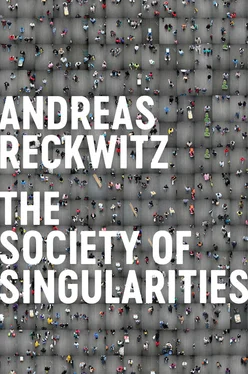Any number of a subject’s characteristics and activities can be regarded as singular: his or her behavior, cultural products, appearance, bodily features, and biography. However, these things have to be performed in some way so as not to be mere idiosyncrasies but to be recognized as unique. The singularization of the subject is a process in which self-modeling and self-singularization go hand in hand with the control and singularization enacted by others. In late modernity, techniques for singularizing subjects have become ubiquitous, both in the professional world, where extraordinary performance is desired, and the private sphere. Typically, then, subjectification and objectification (the social fabrication of objects) – that is, the singularization of people and the singularization of things – are closely connected to one another: subjects make themselves distinct through the uniqueness of their objects (through their internet profiles, for instance, or through the way in which their apartments are decorated). 25All of this makes it clear that the idea of indivisibility, which the old concept of the individual of course entails, is inapplicable to techniques of singularization, because here uniqueness is in fact composed of a variety of components or modules. 26
When spaces are singularized, they are elevated to what theorists of space have come to call places . 27The difference between space and place is the same as the difference between spaces in the social logic of the general and spaces in the social logic of singularization. Places are singular spaces in which material objects are arranged, endowed with meaning, and offered to be perceived in such a way that they are experienced as inherent complexities with specially composed spatial densities – as spaces unconfined by the standardization to which spaces are subjected in the social logic of the general. Such places are not simply used and passed through; rather, they seem valuable and emotionally attractive to those participating in them. Charming cities such as Venice and Paris – with their layouts and atmospheres, but also with the cultural associations and memories associated with them – are historical prototypes for “intrinsically logical” places. 28Yet places of worship, palaces, sacred buildings, exceptional landscapes, monuments, and even apartments and atmospherically rich office landscapes in the creative branches can also be special places in this sense. Whereas, in the logic of the general, all spaces are meant to fulfill a particular function in the same way, the logic of the particular turns spaces into places of identification. Here, to some extent, space is not extensive but rather intensive. Here it is the locality of the space that interests people. Only a space that has been condensed into a place can become a locus of memory and a setting with atmosphere . 29
Temporalities are singularized when they do not take on the form of a typified custom or rationalized routine but are rather oriented around a unique point in time with its own density. Its duration can vary, ranging from a very brief moment in the here and now to a longer episode with a clear beginning and end. Singularized time thus has the form of an event that is actively and intensively experienced. Uniqueness can indeed mean that something happens only once, but this does not necessarily have to be the case. Despite its repetitive character, for instance, a ritual (such as a yearly celebration) can be experienced as unique, and in fact celebrations and rituals are the traditional prototypes of singular temporalities. In late modernity, however, there has been an increasing proliferation of one-off events. From festivals and sporting events to TED conferences, events can be experienced as singular just as much as professional or political projects .
In this case, time is not something that is habitually or routinely filled in order to achieve certain objectives beyond the present. For its participants, on the contrary, it has an intrinsic value of its own; it is experienced in the moment of its seemingly overwhelming complexity – in the presence of its presentness, so to speak. 30Whereas, in the mode of the general, temporality is desensitized to the present moment of activity and instrumentally oriented toward the future, in the mode of the particular it is present-oriented. However, such experiences might also involve references to the past: the memory of a previous event or the establishment of historical connections can serve to enrich the present. For this reason, historical narratives – which cultivate our “historical memory” of past events, moments, places, or people to the point of nostalgia – are likewise variations of temporality within the social logic of the particular. 31
Singular collectives are not general, instrumentally rational associations or (idiosyncratic) “given” social milieus; rather, they are collectives that have a unique cultural value for their participants. According to one theory of modernization, they might be referred to as “particular groups,” yet in this case the semantics of the particular is meant to devalue them as insignificant elements with limited scope as compared to the vast and general organizations of modern society. In reality, however, these collectives are more than just a part of something grander; from the perspective of their members, they are, rather, complete cultural universes of their own with high degrees of communicative, narrative, and affective complexity and significance. This was already true of any family genealogy with its own collective consciousness, but also of early-modern guilds and corporations whenever they were more than just instrumentally rational institutions. In (late) modernity, the singularization of collectives might also occur, for instance, in cultural and aesthetic subcultures, in self-chosen religious collectives, as well as in nations or regional communities (though in a somewhat different way).
In general, the old distinction between community and society applies only under certain conditions to the difference between collectives in the mode of the particular and collectives in the mode of the general. Unlike traditional communities, into which one is simply born, modern “neo-communities” (as they have come to be called) are chosen . Singular collectives are thus, in general, intensively affective socialities that share not only practices but also narratives and imaginations. Unlike collectives in the mode of the general, which appear identical from the outside, the unique nature of singular collectives can appear utterly alien to outsiders and even evoke aggressive contempt. It is especially on the level of collectives that singularities become the object of culture wars. 32
The kaleidoscope of singularized entities that I have presented here perhaps raises a question: can every given object, subject, collective, spatiality, and temporality be singularized? Is inherent complexity entirely a matter of social construction? This question is of little importance to sociological analysis, for here the crucial issues are that and how singularization has taken place. That said, I am inclined to adopt a social-constructivist instead of a radical-constructivist position. On the one hand, what counts or does not count as unique depends on the practices of observation, evaluation, production, and appropriation discussed above. Nevertheless, one can assume that certain entities are somewhat easier to singularize than others: objects, subjects, etc., contain varying degrees of “affordance,” which means that they can differ in what they offer. 33They contain in themselves and offer varying levels of inherent complexity, which are more or less suitable to social singularization. Hieronymus Bosch’s Garden of Earthly Delights is easier to recognize as being inherently complex than a brick, James Joyce’s Ulysses is easier to recognize as such than a novel by Rosamunde Pilcher, and the singer Madonna is easier to see as such than “the Lithuanian assistant film director in the gray coat.” 34But, of course, there is no automatic way of knowing. Under certain circumstances, even stones (as relics, for instance), cheap novels, or gray coats can become cult objects, and renowned works of art and world-famous pop stars can fall into oblivion. In any case, it is clearly insufficient to speak of singularization in sweeping terms; rather, it is necessary to examine the specific practices through which this process occurs.
Читать дальше












